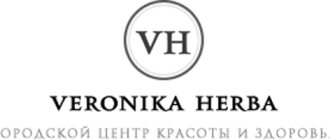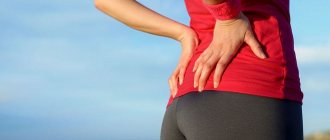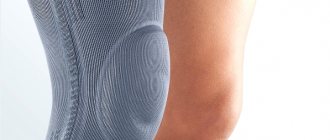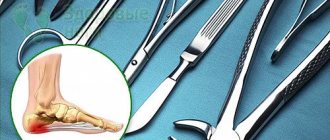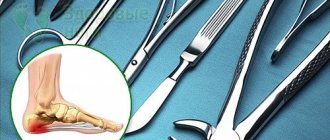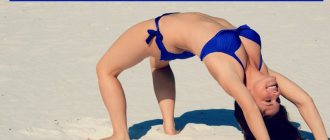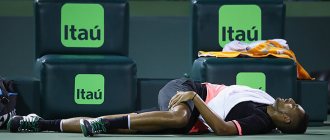We often forget about our musculoskeletal system - muscles, bones and joints - and pay attention to it only when something starts to hurt. A sedentary and sedentary lifestyle has become our daily routine, and not everyone can afford a gym membership and a personal trainer. In this material we will look at the causes of back pain and talk about effective exercises for the musculoskeletal system. They do not require exercise equipment or dumbbells; they are suitable for any age and different levels of physical fitness.
Facts about Traction Therapy
High efficiency and safety.
The method of treating spinal diseases with extensions (tractions) has been known since the time of Hippocrates. Stretching has proven itself as a method of treatment after injuries, congenital and age-related changes in the back. Traction therapy is highly effective, comfortable and absolutely safe for patients.
A unique technique.
Traction therapy of the spine using computerized 3D stretching has appeared in Russia only recently. There are very few devices of this type in Russia, literally a few. And one of them is available at the Center for Restorative Medicine and Rehabilitation of the Federal Scientific and Clinical Center of the Federal Medical and Biological Agency.
Innovative technologies.
Unlike a traditional "one-dimensional" table, where the doctor uses a mechanical device to pull the patient's body up (cervical traction) or down (through weights suspended from the legs), the Spinetronics Robotic-ATT Antalgic-Trak operates in all directions.
Professional control.
Soft, individually selected tractions directed in different directions literally straighten the spine and intervertebral discs in all directions. The intensity and duration of therapy is controlled by a computer, under the supervision of a physician.
Sign up for a consultation with a chiropractor and learn about the possibilities of robotic traction therapy specifically for your situation!
What is traction therapy
Intervertebral discs are gel-like “pads” surrounded by a dense fibrous ring that connect the vertebrae to each other and provide them with mobility, shock absorption during movement and protection from abrasion. With age, under the influence of injuries or incorrect body position, the condition of the intervertebral discs is impaired.
As a result of pathological processes, the gel-like mass can become thicker and more rigid. The nutrition of the intervertebral discs may be disrupted, and as a result, damage to their capsule—a thin layer of cartilage—occurs. Often, discs become deformed, protrude beyond their anatomical position, pinch nerves, and compress blood vessels.
All this can lead to complaints of pain in the spine (back) during movement and at rest, in a lying or sitting position, as well as to disruption of the blood supply to the brain through the vertebral arteries, headaches, insomnia, dizziness, tinnitus, etc. . P.
Tractio or traction is a method based on the physiology and anatomy of the spine. Traction therapy stretches the spinal column, giving it its original position and allowing the discs to fall into place and stop pinching blood vessels and nerves.
Traditionally, traction is performed on a special table. The patient lies down on a special table, his head is fixed with a hammock. Then the table tilts downwards, and the body’s own weight begins to stretch the spine. In another version, the load is suspended from the legs, and traction occurs due to its mass.
Traction therapy on the Spinetronics Robotic-ATT Antalgic-Trak device is more comfortable for the patient: half-sitting, periods of stretching alternate with periods of weakening traction. The device also allows you to select the direction, strength and duration of traction shown in a particular case. For safety, a patient-controlled emergency shutdown device is provided.
“PravIlo” - ancient Russian simulator
The secret lies in the ability to extract additional energy not from the muscles, as is traditionally done (in the fitness room, strength exercises, jogging, swimming, etc.), but from the bones, ligaments and tendons - an unaccounted source and reservoir of physical and vital force , unexhausted and unclaimed in modern life.
By gradually stimulating bone tissue and, especially, bone marrow, which accumulates solar energy in large quantities, a person learns to release this energy, including coordinated image, breathing and movement in the stretching process. (By “image” we mean the ability, during exercise, to mentally cover with attention the reference points in the body, equidistant from the center, located in the solar plexus.)
In addition, as a result of horizontal traction on the simulator, the human spine is unloaded in a way that is not achieved in an ordinary hang on a bar. Pathological clamps (fixations of tension in the body), formed throughout life, are weak links in the entire chain of processes taking place in the body. Their complete removal is possible in different ways. One of the most effective, in my opinion (based on my five years of experience with corrections on this simulator), is horizontal traction, where the load is evenly distributed during tension and relaxation, producing compression and expansion of the musculoskeletal system like inhalation and exhalation.
This also entails improved posture, increased body tone, making the skin smoother and more elastic, walking easier, contributing to the influx of additional reserve forces and prolonging life.
Volodarsky B.I. about the "rule"
Boris Ivanovich, where are you from?
— I come from Karelian Pomerania, Tver (Kalinin) region. Where did the gift of healing come to you?
- From living on your own land (not in the city): from working on it, from food grown on it with your own hands, from pets. From the Ancestral Power, inherited from the grandmother. From life experience and knowledge. What methods do you use?
— My healing system includes the use of natural elements - earth, water, air, fire, solar energy. I use special exercises, as well as stretching on the rule (emphasis on the “and”) and casting with beeswax. The most important thing is for the patient to believe in his own inner strength, that there are no incurable diseases and that at any age you can start a new life. The very word “treatment” is criminal, not treatment, but liberation from the disease.
What is a rule?
— Pravilo is an ancient Russian simulator for correcting a person in the process of life, for him to gain strength and endurance. Stretching on the rule returns a person to the “original” state, relieving tension in the body that has accumulated during life. How do you feel about psychics?
— Without a kind, energetically compatible, equally-minded wife, as well as natural living conditions, there is no Russian healer, but there are psychics generated by dark forces. Therefore, the attitude towards psychics is negative. A huge number of psychics and different “schools” are the result of anti-Russian perestroika. I always say: “If you are a Slav, a Russian, then drink milk only from a Russian cow!”
Do you have the gift of foresight?
— Knowing in advance is a great power, my parents told me this, and this gift is present and develops throughout life in every normal healthy Russian person. The gift of foresight for me is a premonition, intuition, and extensive life experience. If a situation requires a quick resolution, then foresight is expressed in the form of warning signs. If you need a detailed answer to a question, then in the morning, at dawn, the answers always come. What is the root of the disease, and how should a person live in order not to get sick?
— The root of the disease is in our consciousness, which forms our unhealthy lifestyle, which, in turn, leads a person to disease. It's never too late to start a new life according to the laws of Nature and Space, which include a whole system of human behavior that allows you to strengthen, and not destroy, your family, your Family. Andrey Polyakov
Setting up a house rule
Details for the rules:
Winch - 1600 (available inexpensively in special stores with equipment for service stations) Slings 4 meters - 200 Washers 12 pcs - 30 Elastic bandage 3m - 50 (you can without it, cut off the sleeves from an old sweater) Cable 2mm x 15m (you could have taken less 2 times) - 100 Rivets for the cable 4 pcs - 10 Block rollers 5 pcs - 1090 Chain 0.5m x 2 - 100 (cut right in the store) Screw anchor-hooks 5 pcs - 100 Screw anchor-bolts for attaching the winch 3 pcs -60 Carabiners 9 pcs (you could take 7) - 230
Total = 3570 rubles.
Some photos are correct.
spare parts:
This is how the leg is attached:
This is what the cockpit looks like:
https://www.seorp.ru/ Tendon exercises by Zass (Iron Samson)
“Some people with thin legs are stronger than people with thick legs - Why? Because the power lies in the tendons, in those invisible hard tissues that are second in density only to bones. Without tendons, a person would turn into jelly. But the tendons need to be trained. From my experience, one can be convinced that a large man does not necessarily have to be strong, but a man of modest build does not have to be weak.
I don't believe in big muscles unless there's real big tendon power next to them. You can see physical fitness enthusiasts who have quite large muscles. But what good are they if there is no powerful foundation - developed tendons. They are unable to fully utilize the strength of their muscles during an actual test of strength. And therefore their power is only an illusion.
Tendons increase their strength best when their power is applied to some almost immovable object. They become stronger from resistance than from movement.”
Alexander Zass, or Iron Samson, created an ingenious system for developing strength.
Here the supporting part of his system is presented: the development of tendon strength.
“I never strived for big muscles, believing that the main thing was strong tendons, willpower and the ability to control my muscles. When I started performing in the circus as an athlete, my biceps were only 38 centimeters. But the public needs a look, and I had to increase them to 42 centimeters through exercises with dumbbells and self-resistance exercises” (from a letter to Yuri Shaposhnikov).
“Big biceps are not a sign of strength any more than a big belly is a sign of good digestion.”
Alexander Zass achieved phenomenal strength density with the help of tendon exercises. Short, weighing 66 kg, at the beginning of his wrestling and athletic career, he caused confusion among spectators with his exploits: he defeated huge opponents, broke chains and horseshoes, tied metal rods with a bow, restrained horses rushing in different directions... Because of this confusion, Zass had to gain more weight muscle mass to rid viewers of suspicions of deception. However: throughout his entire circus career, his weight never exceeded 80 kg.
Tendon exercises have been generally known since ancient times. People's strongmen lifted and carried huge stones and large animals, practiced bending and unbending metal rods and horseshoes, dragged tree-boats-carts behind them, restrained rushing bulls and horses... In ancient Rome, athletes dressed in iron robes weighing 200-300- 400 kg and so climbed onto the platform...
But it was Zass who was the first to be lucky enough to recognize the system in the phenomenon and present it to the world. This happened in 1924.
“We need to develop what underlies the muscle, especially the tendon, not the volume of the muscle.”
In the early 60s, naive Americans rediscovered the Sass effect, calling these exercises isometric and static. Since then, tendon exercises have become part of active sports practice: to develop strength, to overcome dead spots, to form new trajectories of power movements. But here they remain separate, isolated exercises. But the system already exists!
Alas. Authorities in sports and science prefer to keep this fact in the shadows and, as a result, are forced to fool ordinary people. After all, the tendon system is phenomenal in many ways: it can be practiced with a minimum of space, equipment, and time and with excellent effect. It is no coincidence that the circus strongmen of our time - Gennady Ivanov and Ivan Shutov - used the Zass system as the basis for the development of strength.
That's why experts have to look for sunspots. They will announce that isometric straining is harmful to the heart, blood vessels, and nerves, especially those who are unprepared, such as young people or amateurs (this is not true); then they will tell you how dynamic training (complex!) surpassed isometric training (simple!); then they will remember about potentially all kinds of micro and larger tears in muscle tissue and other irreparable dangers of maximum strain.
Another way: mix concepts. They say this is the same as Anokhin’s volitional gymnastics. Here's a good home isometric complex without projectiles. Only 4-6 seconds and only after a year you can increase the voltage time to 8 seconds. And 12 seconds or more is a direct threat to health. Listen to yourself: if you get a headache, quit this disastrous business immediately. Stress only while inhaling. Train for no more than 15 minutes!
The usual thing is the opposite. The real blemish is the recent history of isometrics. In the early 60s, Bob Hoffman organized the release of miraculous power racks for isometric exercises and in his magazine “Strength and Health” he touted with all his might the cool achievements of Bill March and Louis Riquet, who added several hundred pounds to their all-around competition in six months. Many have made decent progress, but no one has been able to repeat the fantastic breakthrough of March and Rike. And finally it turned out that there was another reason for their rise - steroids. The scandal simultaneously and permanently damaged the reputation of isometrics.
Nevertheless: this was the first large-scale experiment. Equipment was plentiful, and a few years later a scientific study of 175 athletes doing isometrics showed an average weekly 5% increase in strength. Wow!
It was at this time that isometrics became firmly established in world-class sports practice, but at the same time remained narrowly focused, boring and far from ordinary amateurs.
But how simple it could be: if you reissue 2 original books by Alexander Zass + the book “The Amazing Zass” of 1925, if you show how exactly chain voltages act - on themselves and in the system, if you still take into account new experience “in favor” of the system Zassa.
In the meantime, let’s answer objections and confusion:
• The Zass system also includes dynamic exercises with a bag. And apparently the newest revelations of the Gurias of bodybuilding are slowly approaching the Zass system. On the other hand, progress is an objective thing and they also have something to improve - to update the Zass system.
• Complex tendon training includes not only statics, but also “pumping” of the entire joint volume by tension. That is, the development of the tendon spring, the development of the connection of the tendons with the joint and with the muscle, the distribution of the tendon force density over the entire motor range of motion, the development of accompanying balances-regulations-controls. And it’s natural to use different modes of tendon training: for example, stops, carrying weights, standing like a “pillar” or “rider” or just like that, holding a barbell with your body... warming up, mobilizing, maximum...
• The danger of straining for health is directly related to disturbances in energy and physiological regimes: first of all, nervous and improper breathing, then a disruption of the processes of prompt and long-term recovery, and finally, this is a practice of narrow-private use leading to distortions in the overall energy exchange. All these syndromes can be reproduced without isometrics - in any activity, and even more so in sports.
• Gymnastics Anokhina lives next door and some of her exercises can very well complement tendon gymnastics. But!! — volitional gymnastics is muscular gymnastics. Its closest relatives are Hermes gymnastics, hatha yoga, and stretching.
• However, a direct close relative did appear. This is Vladimir Fokhtin’s autonomous gymnastics, self-resistance gymnastics. She, too, has a hard time with experts: they will either declare her to be Anokhin’s gymnastics, or describe her usefulness as tasks for toning up ordinary people or as a temporary means for business trips, or remember the dangers of isometric exercises. Indeed: Fokhtin’s gymnastics develops tendons, develops joints, develops muscles. At the same time, it requires a minimum of space and absolutely no shells. True, the author followed the lead of the experts and somewhat overcomplicated the starting course to 88!!! exercises. It's not even a matter of quantity - it's a complete system, the problem is the structure of the delivery of these exercises. Plus, the author carefully distanced his gymnastics from isometrics and self-exertion. But in fact, Fokhtin took the next step in the development of athleticism and tendon gymnastics.
• About the 6-second mode, in which the maximum force is 2-3 seconds. Unfortunately, I don’t know Zass’s own opinion about this.
But here's what we know:
a) Zass in prison practiced 15-20 second tensions, therefore, under normal conditions and with normal nutrition, he could use minute tensions. b) In the first 6-8 seconds, the ATP reserve is burned, then glycogen comes into play and fat is ignited at 40 seconds. The problem is that the isometric way of expending and restoring energy conflicts with the aerobic dynamic way. In general, if you don’t change anything, then you really have to choose “either or”. If you choose isometrics, then naturally 4 modes of tension are revealed: 6 seconds, 15-20 seconds, 1 minute, 3-6 minutes. But they still need to be awakened, treated, developed... Otherwise, it is very easy to overtrain and fall into a viscous pit of distress.
The tendon system of developing strength using chains is original and fresh to this day. The Zass system allows you to quickly increase strength, strengthens ligaments and tendons, creating a foundation for the natural development of muscles.
Note for women: proper performance of tendon exercises does not increase muscle volume, does not enlarge veins, includes subcutaneous fat in the overall energy exchange (promotes resorption and improvement of the skin), improves character and the ability to stand up for oneself. True, you will have to show taste and ingenuity in selecting exercises.
Tendon exercises can be performed using different equipment - a metal rod, chains, a thick cord, a wooden stick. You can use furniture, walls, doorways. Try to bend a thick metal rod or break a chain, squeeze a stick, lift a door frame: muscles and tendons tense, the whole body is involved in a ringing force wave, ripens to maximum density... and smoothly returns back to peace. By repeating these tests several times, we develop and strengthen the force wave and, with it, the strength of the entire body.
Rules for tendon gymnastics
• your object is your body, so don’t break the chain - just create a dense body wave, the chain will break itself • breathe calmly, without straining your breath when making an effort, exercise against the background of calm breathing • the power wave should cover the entire body, from the soles to the working implement ; at the same time, as if pressing your body into the force - this will increase the volume of the muscle-tendon-joint connection • the wave should be good: smooth-elastic entry, strengthening without breaks to a fairly maximum density, smooth-calm exit • develop the natural strength of good nature: minus nerves , minus the result, minus the breathing, plus a volumetric body wave - this way you will avoid all the “dangers”, including headaches and protruding veins • strained the force - let go, listen to the restoration of strength with gain; gain is new energy, you have nothing to realize it with, so we focus on recovery + the feeling of uncertainty that accompanies the arrival of strength • perform the exercise 1-5 times with standard pauses from 30 to 90 seconds; with more powerful efforts, you may need longer pauses from 3-5 to 10 minutes (experiment) • if the breathing deepens, the heart is pounding, the force wave breaks or shows bodily discomfort - then you need to stop and calm down, reduce the effort, massage - feel the discomfort with a gentle wave • do not rush, let the total duration, magnitude of effort and duration of the maximum develop naturally; start with short 2-5 second tensions, and enter longer ones more gradually • in a tonic-daily mode, select 5-8 favorite exercises and perform them in 1-3 tensions with an effort of 60-90-75% (approximately) • full strength training should be performed no more than 2 times a week and take no more than an hour; here, for 5 repetitions, you can focus on the following efforts - 75-90-95-90-75% of the satisfied maximum • daily stress is best combined with the mindset for the day or task, strength training is best tuned to the image of the week or goal
Once a week, at the end of a strength training session, I advise you to perform a tonic test: a minute stretch of a stick-chain-towel, with your arms down, with an effort of 95%. After stretching, listen to your hands: if the muscles are healthy, then the hands will rise to the sides and up and hover there for a while (on the side or at the top). The amount of this time - the amount of tonic activity - will indicate to you your weekly progress not only in strength, but also in its quality. If there is no progress, then it means you are doing something wrong: you are not getting enough sleep, you are overeating, you are worried, you are burnt out in business, you have not had time to recover from the previous workout, you have pushed yourself too far in this workout. If your tonic activity is less than a minute, be doubly careful with overexertion. If your tonic activity is above 1.5 minutes, then you can be congratulated: you are doing everything correctly and quality progress in strength is guaranteed to you.
Advantages of traction therapy at the Federal Research Center of the Federal Medical and Biological Agency of Russia
The Center for Restorative Medicine and Rehabilitation of the Federal Scientific and Clinical Center FMBA is the only one in Moscow and one of several in Russia where the Spinetronics Robotic-ATT Antalgic-Trak device is installed.
Specialists from the Federal Scientific and Clinical Center FMBA were trained by the company that develops this device and the technologies for its use. Patients have the opportunity to undergo a full examination if they complain of back pain and complex traction therapy.
The experience of doctors and rehabilitation medicine specialists in the diagnosis and treatment of diseases, injuries and age-related changes allows us to select the optimal treatment and stretch the spine exclusively with an individual calculation of strength, duration, frequency and other parameters of 3D rehabilitation.
We have developed several traction treatment programs for patients with various diseases of the spinal column. Depending on the indications, either a short or long course of 3D rehabilitation can be prescribed - from 1 to 15 sessions.
During traction therapy on the Spinetronics Robotic-ATT Antalgic-Trak, the computer continuously monitors the load distribution in all directions and, if necessary, optimizes it to be safe and at the same time as effective as possible.
Traction 3D rehabilitation: easy movement without back pain!
Exercises 1 complex:
| 1. Stretch the chain with your right hand bent while holding the other end of the chain straight with your left hand. Change your starting position. |
| 2. In the starting position, you can keep your hands wider than shoulder-width apart or shoulder-width apart. When stretching the chain, tense not only the arm muscles, but also the pectoral muscles and latissimus dorsi muscles. |
| 3. While stretching the chain with your arms bent in front of your chest, tense mainly the muscles of your arms and chest. |
| 4. Chain behind your back. As you stretch the chain, focus primarily on your triceps. |
| 5. Chain behind your back. When stretching the chain, tighten mainly the muscles of the arms (triceps), pectoral muscles and abdominal muscles. |
| 6. As you exhale, wrap the chain around your chest and secure it. Taking a deep breath, stretch the chain, contracting your chest and latissimus dorsi muscles. |
| 7. This exercise requires two chains. Attach leather loops to one end of each chain and thread your feet through them. When stretching the chain, tense mainly the trapezius and arm muscles. |
| 8. While stretching the chain, change the starting position of your hands. Focus mainly on your triceps and deltoids. |
| 9. While stretching the chain, change the starting position of your arms and legs. |
| 10. Stretch the chain alternately on the right and left thigh. |
| 11. Stretch the chain, change the starting position of your legs, arms and torso. (Tilt to the left leg, then to the right.) |
| 12. While lying on the floor, stretch the chain, tensing the muscles of the shoulder girdle and triceps. Keep your body tense. |
| 13. In a handstand, stretch the chain by tensing the muscles in your arms, back, and neck. When balancing, transfer the load to your fingers. |
| 14. Use two loops for this exercise. While stretching the chain, tense the muscles of your neck and back. |
| 15. When performing exercises to develop the muscles of the arms and quadriceps, change the position of the arms and legs. |
| 16. For this exercise, use two loops. As you stretch the chain, tighten your hamstring muscles. Using the same chain, stretch it by moving your leg to the side. Change the starting position of your legs. |
Check yourself: are you at risk for spinal diseases?
Answer a few questions:
- Do you feel back pain after static exercise (sitting at a desk, lying in a certain position)?
- Does your middle or lower back hurt after walking?
- Do you have a constant feeling of heaviness in your back, do you find it difficult to find a comfortable position?
- Does getting up from an easy chair cause pain or discomfort?
- Do you lead a sedentary lifestyle (less than 30 minutes of daily physical activity)?
- Have you been or are you involved in sports with increased loads (including fitness, strength training, running)?
- Are you overweight?
- Have you been forced to lie down for a long time (surgery, injury, paresis)?
- Have you previously suffered a spinal injury?
- Did/do you have scoliosis?
- Are you experiencing any or a combination of these symptoms: dizziness, headaches, difficulty falling asleep, tinnitus, shooting in the arm or shoulder?
If you answered “yes” to at least 2 questions, you should definitely make an appointment with a rehabilitation doctor.
He will diagnose the condition of the spinal column and, if necessary, give recommendations for treatment, including the use of traction therapy.


